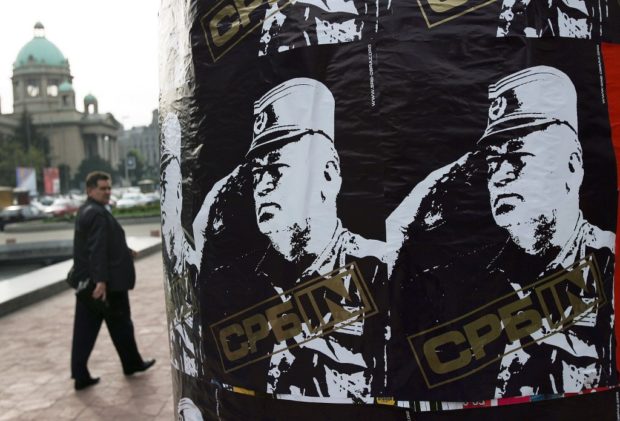For nearly four years Serbian artist Vladimir Miladinovic started his day with a morning coffee and the diary of one of the Balkans’ most notorious war criminals, Ratko Mladic.
Word for word, he painstakingly copied the notebook’s 400 pages by hand onto fresh white sheets, which now cover the walls of a Belgrade exhibit raising questions about how to confront one of the region’s darkest chapters.
For the 39-year-old artist, the task was in part a “performative act of trying to deal with this very harsh material which we are still forced to deal with today, 25 years after the war”, he told AFP from the austere gallery on the banks of the Danube.
His subject, the 77-year-old former Bosnian Serb commander whose troops committed genocide in Srebrenica among other war crimes during Yugoslavia’s collapse, was sentenced to life in prison by an international tribunal in The Hague in 2017.
His appeal trial is due to start on August 25.
Yet while the legal process moves forward, the wounds he left in former Yugoslavia still fester and his personal legacy remains a battleground.
Many Serbs still consider Mladic a hero and deeply distrust international courts they feel are biased against them.

After his conviction in 2017, Serbian President Aleksandar Vucic called on the country to “start looking to the future”.
But Miladinovic has gone in the other direction: finding artistic inspiration through immersing himself in the granular details of his country’s troubled history.
His previous works have involved a similar redrawing of wartime newspaper pages and primary documents that deal with the “problematic parts of the past that are still negotiable in the present”.
– ‘Banal’ –
Lining the walls of the stark gallery space, the diary entries are easy to read — written in simple, spare language with ink wash — but their sheer number makes them difficult to fully absorb.
Spread out page for page, they make visible the effort needed to face one’s history, individually and collectively through institutions like a court.
And yet the pages themselves reveal little about the writer.
Drafted in militaristic prose, these are not the crazed scribblings one might expect from a man deemed the “epitome of evil” by a UN rights chief.
Rather, they are a neat log of notes from political and military briefings, with bullet-point lists recording each speaker’s remarks.
“In the end we can say that it’s even banal, banal language that says nothing but at the same time says a lot,” the artist said.
Some entries are purely logistical, for example one that notes the limited supplies of flour and oil for a local bakery.
Another details the precise number of Serbs in various Bosnian towns, eerily bringing to mind the ethnic cleansing that took place as Mladic carved out a Serbs-only statelet in an area once shared with Croats and Muslims.
“We have a state on a platter, we just need to take it,” reads one comment in a conversation with Momcilo Krajisnik, a Bosnian Serb political leader also convicted by the International Criminal Tribunal for the former Yugoslavia (ICTY).
Mladic’s own point of view is hard to find, though in one entry he writes under the words “my contribution” that Bosnia’s Serbs need “unity”, “manpower and officers”, “funds for conducting a war” and “allies”.
– ‘Opposite’ of forgetting –
The art exhibit, titled “The Notebook”, is only the latest incarnation of the diary.
Dating from 1992, the start of Bosnia’s war, it was one of some 18 notebooks discovered by ICTY investigators behind a fake wall in the Belgrade home of Mladic’s wife a decade ago.
At the time, the man himself was still on the run and would not be arrested until a year later in Serbia, ending a 16-year manhunt.
Handwritten in Cyrillic, the diaries were transcribed by a team of graphologists into a digitised version.
This text was then translated into English and French for the court’s international members.
Miladinovic continued the cycle, using the English text as the basis of his own work.
The exhibit has garnered more attention internationally than at home, which does not surprise him.
“The work itself is trying to do something which is the opposite of what (Serbian) society is trying to do, to forget — to deny, to erase such important issues from the past,” he said.
ssm/gd/bp
© Agence France-Presse